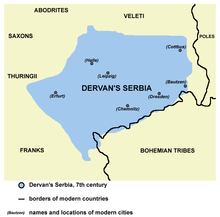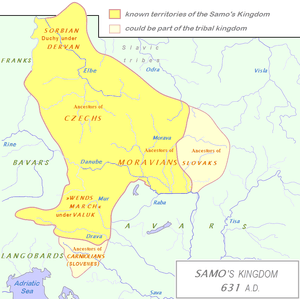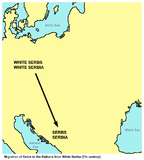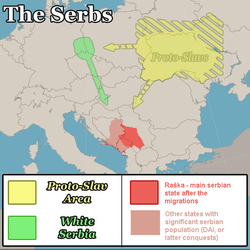White Serbia
White Serbia (Serbian: Бела Србија / Bela Srbija; Sorbian: Biеło Srbsko), called also Boiki (Ancient Greek: Βοικι, romanized: Boiki; Serbian: Бојка / Bojka; Sorbian: Boika), is the name applied to the assumed homeland of the White Serbs (Serbian: Бели Срби / Beli Srbi), a tribal subgroup of Wends, a mixed and the westernmost group of Early Slavs. They are the ancestors of the modern Serbs and Sorbs. Boiki is mentioned in De Administrando Imperio, a 10th-century work by Byzantine Emperor Constantine VII (r. 913–959). According to it, the "White Serbs" lived on the "other side of Turkey" (i.e. Hungary), in the area that they called "Boiki" (Bohemia). The area adjacent to it was known as White Croatia, from where the White Croats trace their origin.
Location
Sources
Constantine VII in De Administrando Imperio recounts in Chapter 32, "It should be known that the Serbs are descended from the unbaptized Serbs, also called ‘white’, who live beyond Turkey, in a region called by them Boïki, where their neighbor is Francia, as is also Megali Croatia, the unbaptized, also called ‘white’. In this place, then, these Serbs also dwelt from the beginning... Now, after the two brothers succeeded their father in the rule of Serbia, one of them, taking one half of the folk, came as the refugee to Heraclius, the emperor of the Romaioi... Then, after some time these same Serbs decided to depart to their own homes, and the emperor sent them off. And so, when they had crossed the Danube River, they changed their minds and sent a request to the Emperor Heraclius... the emperor settled these same Serbs in these countries".[1][2]
In the 33rd chapter he says, "(It should be known) that the clan of the anthypatos and patrikios Michael, son of Visevitz, archon of the Zachlumians, came from the unbaptized inhabitants on the Visla River, called Litziki, and they settled on the river called Zachluma".[1][2]
A Latin document from the early 10th century said that the "Hungarians moved to Pannonia from Serbia (Ungarorum gens a Servia egressa in Pannoniam)". Živković suggest that this likely refers to Boïki (Bohemia).[3]
Dispute
Theories on the location of the so-called "Boiki" and "White" Serbs have been disputed, but it is generally established to have been around the region of Bohemia and Saxony.[4][5][6][7][8] Since the 19th century, two most prominent theories were of Bohemia, and the land of the Boykos in Eastern Galicia in the Carpathians. The latter was mostly argued by 19th-century scholars, like Pavel Jozef Šafárik (1795–1865) and Henry Hoyle Howorth (1842–1923),[9] who also included the White Serbs among the Polabian Slavs.[10] Rather than relating Boiki and Bohemia, which in turn derived from ethnonym of the Celtic tribe Boii, they related the toponym to the much younger ethnonym of the Rusyns sub-ethnic group Boykos. Béni Kállay (1839–1903) noted that many historians assumed that Serbian territory was identical to the Czech lands (Bohemia) based on DAI's account and the name Bojka, but he also supported Šafárik's thesis.[11] Other scholars who had a similar opinion were Vladimir Ćorović (1885–1941),[12] and Ljubivoje Cerović (b. 1936).[13] However, most scholars like Borivoje Drobnjaković (1890–1961),[14] Andreas Stratos (1905–1981),[6] Sima Ćirković (1929–2009),[15] and Relja Novaković (1911–2003) located them to the West in the area between the Elbe and Saale rivers, roughly between Bohemia and East Germany (Polabia).[16] According to Mykhailo Hrushevsky (1898), Gerard Labuda (1949), Gyula Moravcsik (1949), Jaroslav Rudnyckyj (1962–1972) and Henryk Łowmiański (1964) unlike Croats, there is no proof that Serbs ever lived within Bohemia or in Eastern Galicia, only that they lived near Bohemia, and the connection between Boiki and Boykos is considered to be scholarly outdated and rejected.[4][5][17][18]
According to archaeologist V. V. Sedov (1995), the 32nd chapter of De Administrando Imperio indicates it was located in the Lower Lusatia territory where were located the Sorbs,[19] but the 33rd chapter about Zachlumia caused confusion which resulted with several hypotheses.[20] The first group of scholars argued the homeland existed between rivers Elbe and Saale, the second in the upper course of rivers Vistula and Oder, and the third from Elbe and Saale to the upper course of Vistula.[20] However, Sedov concluded that the archaeological data does not confirm any of these hypotheses, and most plausible is the consideration by Lubor Niederle that there's no evidence that White Serbia ever existed and Constantine VII most probably made up Northern Great Serbia only according to the analogy with Great Croatia,[20] which by other historians also did not exist.[21] According to Tibor Živković, the structure and content of the subchapter about the family of Michael of Zahumlje indicates that this account was likely told by Michael himself. He is not noted as being of Serbian origin. Živković thought Michael's family may have preserved the memory of their tribal origin.[22]
Toponyms and antroponyms
Tadeusz Lewicki in his toponomastic research of Polish lands found many toponyms documented between 12th and 14th century with a root "Serb-" and "Sarb-" and defined them as both a trace and remnant population of the so-called White Serbs in DAI. However, according to Hanna Popowska-Taborska, the method didn't take into account the unambiguous etymological interpretation of the Serbian ethnonym because of which most probably the majority of the toponyms don't derive from the ethnonym itself. Łowmiański and Popowska-Taborska found them and their abundance unusual which cannot reflect the early medieval great migration of the Slavs, and it rather describes the contemporary Sorbian population living on the Polish territory. As well cannot be considered early medieval origin of the Polish 13th-15th century personal names which possibly derive from the ethnonym.[23]
Gallery
 Dervan's polity in the 7th century.
Dervan's polity in the 7th century. Samo's realm in 631, including Dervan's polity.
Samo's realm in 631, including Dervan's polity. White Serbia and White Croatia (around 560), according to Francis Dvornik.
White Serbia and White Croatia (around 560), according to Francis Dvornik. Lusatian (Sorbian) theory.
Lusatian (Sorbian) theory. Lusatian (Sorbian) theory, including Proto-Slavic lands.
Lusatian (Sorbian) theory, including Proto-Slavic lands.
See also
- Sorbs (tribe)
- White Croatia
- List of Medieval Slavic tribes
References
- Živković 2012, p. 152–185.
- Sedov 2013, p. 458–459.
- Živković 2012, p. 153.
- Mykhailo Hrushevsky (1997) [1898]. Andrzej Poppe; Frank E. Sysyn; Uliana M. Pasiczny (eds.). History of Ukraine-Rus'. Volume 1: From Prehistory to the Eleventh Century. Translated by Marta Skorupsky. Canadian Institute of Ukrainian Studies Press. pp. 161–162. ISBN 978-1-895571-19-6.
The second detail in Constantine's account, which supposedly points to the eastern Carpathians, is his reference to a 'place called Boiki (Boiki)' on the border with the White Serbs; for a long time this was considered — and some consider it still – to be a reference to the Ukrainian Boikos. That is very unlikely, however, because the location is too far east for the Serbs, nor is there any indication that the name of the Boikos was ever in such wide usage. So all we are left with to suggest the existence of a Rus' Croatia in the Carpathians is the Primary Chronicle ... Published by H. Jireiek, the Karten zur Geschichte (1897) also show the 'Boiki' on the Dnister (map 4). It is more likely that Boiki is a distorted variant of the name Boiohem, or Bohemia, as most scholars now believe...
- Gyula Moravcsik, ed. (1949). De administrando imperio. Pázmány Péter Tudományegyetemi Görög Filoĺ́ogiai Intézet. pp. 130–131.
...should be modern Saxony, where remnants of Serbs (Sorbs) are still living. The name 'Boiki' has been much disputed over by specialists ... has proved that the 'place called Boiki' can only be Bohemia. Grégoire (L'Origine, 98) rejects Skok's proposal to read 'Boioi', and suggests 'Boimi'. C.'s account contains one serious inexactitude: namely, the statement that the Serbs lived 'in a place called by them Boiki'. Although we have documentation of Croats in Bohemia, we have none to suggest that Serbs lived there. Bohemia was in fact another neighbour of White Serbia
- Andreas Nikolaou Stratos (1968). Byzantium in the seventh century. Adolf M. Hakkert. p. 326.
These, he says, descended from the unbaptised Serbs who were also called "white" and lived in a place called by them "Boiki" (Bohemia)...
- Acta archaeologica Carpathica. Państwowe Wydawn. Naukowe. 1999. p. 163.
Wielu spośród nich osiedlili królowie węgierscy u zachodnich granic swego królestwa; morze Ciemne = Bałtyk; Boiki = Bohemia, czyli Czechy...
- Slavia antiqua. 44. Poznań Society of Friends of Learning. 2003. p. 13.
Serbów balkañskich znajdowala siç w kraju zwanym u nich Boiki (Bohemia=Czechy)...
- Howorth, H. H. (1878). "The Spread of the Slaves. Part I. The Croats" (PDF). The Journal of the Anthropological Institute of Great Britain and Ireland. 7: 326. doi:10.2307/2841009. JSTOR 2841009.
- Howorth, H. H. (7 December 1880). "The Spread of the Slaves. Part III. The Northern Serbs or Sorabians and the Obodriti". The Journal of the Anthropological Institute of Great Britain and Ireland. 9: 181–232. doi:10.2307/2841974. JSTOR 2841974.
- Béni Kállay (1882). Istorija srpskoga naroda. Petar Curčić. p. 14.
- Ćorović 2001, ch. Словени насељавају Балкан.
- Ljubivoje Cerović (2002). Srbi u Ukrajini. Muzej Vojvodine. p. 13.
- Borivoje M. Drobnjaković (1960). Etnologija naroda Jugoslavije. 1 (1960). Naučna knjiga. p. 102.
- Ćirković 2004, p. 17.
- Vizantološki institut (1996). Recueil de travaux de l'Institut des études byzantines. 35. Vizantološki institut SANU. p. 127.
Најпре је посвећивана пажња подацима о прадомовини Срба, односно о Белој или некрштеној Србији о чијем положају на широком простору иза Мађарске а између Лабе и Пољске су и раније у стручној литератури изрицани различити судови. Много пажње овом питању посветио је Р. Нова- ковић, полазећи од унапред стеченог убеђења да сам Константин Порфирогенит тврди да су Срби са северозапада стигли на Балканско полуострво.37 Извесно је да се тако нешто не може наслутити из података цара писца, јер би иначе била сасвим сувишна и не- разумљива дуга расправљања о положају прадомовине Срба па и Хрвата. У трагању за локализацијом прадомовине Срба, односно Беле Србије, Р. Новаковић се уствари вратио на већ одавно искази- вано мишљење да се она налазила у Полабљу. Настојећи да у подацима цара писца открије елементе који би упућивали на западну локализацију Беле Србије, он је пре свега обратио пажњу на детаљ да се она налазила близу Франачке.38 Међутим, Р. Новаковић је желео да изнесе још неке доказе за западну локализацију Беле Србије, на пр. име Бојки којим су Бели Срби, бар по цару писцу, називали своју земљу. По његовом уверењу тај назив, који долази од имена келтског племена Боји, односи се на Чешку (Војоћетшп), што је довољан доказ да прадомовину Срба ваља тражити на севе- розападу простора иза Турске (Угарске) где је смешта спис ВА1.59 Знатну пажњу Р. Новаковић је посветио занимљивом податку цара писца да су Бели Срби од давнина били настањени у својој пра- домовини, а пошто се она по његовом убеђењу налазила у Полабљу, то значи да су Словени овде живели сигурно пре V или чак пре IV века после Христа.40 Касније је Р. Новаковић посебну пажњу после доласка Срба на Балканско полуострво, што показује да су они овде пристигли негде крајем VIII века.
- Łowmiański, Henryk (2004) [1964]. Nosić, Milan (ed.). Hrvatska pradomovina (Chorwacja Nadwiślańska in Początki Polski) [Croatian ancient homeland] (in Croatian). Translated by Kryżan-Stanojević, Barbara. Maveda. p. 16, 76–77. OCLC 831099194.
- Jaroslav Rudnyckyj (1962–1972). An Etymological Dictionary of the Ukrainian Language: Parts 1–11, A–G (in English and Ukrainian). 1. Winnipeg: Ukrainian Free Academy of Sciences (UVAN). p. 162.
- Sedov 2013, p. 458.
- Sedov 2013, p. 459.
- Majorov 2012, p. 58.
- Živković 2012, p. 185.
- Popowska-Taborska, Hanna (1993). "Ślady etnonimów słowiańskich z elementem obcym w nazewnictwie polskim". Acta Universitatis Lodziensis. Folia Linguistica (in Polish). 27: 225–230. Retrieved 16 August 2020.
Sources
- Constantine VII Porphyrogenitus (1993). De Administrando Imperio (Moravcsik, Gyula ed.). Washington D.C.: Dumbarton Oaks Center for Byzantine Studies.
- Einhard. Annales regni Francorum [Royal Frankish Annals] (in Latin).CS1 maint: ref=harv (link)
- Ćorović, Vladimir (2001). Istorija srpskog naroda (Internet ed.). Belgrade: Ars Libri.CS1 maint: ref=harv (link)
- Fine, John Van Antwerp (1991). The Early Medieval Balkans: A Critical Survey from the Sixth to the Late Twelfth Century. Michigan: The University of Michigan Press. ISBN 978-0-472-08149-3.CS1 maint: ref=harv (link)
- Ferjančić, Božidar (1959). Vizantiski izvori za istoriju naroda Jugoslavije. 2. Vizantološki institut SANU. pp. 5, 47.
- Летопис Матице српске. 141–144. У Српској народној задружној штампарији. 1885. p. 145.
- Viktor Novak (1973). Istoriski časopis. 20. Prosveta. p. 7.
- The South Slav Journal. 22–23. Dositey Obradovich Circle. 2001. p. 149.
- Zbigniew Gołąb (1992). The origins of the Slavs: a linguist's view. Slavica Publishers, Inc. p. 397. ISBN 978-0-89357-224-2.
- Ćirković, Sima (2004). The Serbs. Malden: Blackwell Publishing. ISBN 9781405142915.CS1 maint: ref=harv (link)
- Živković, Tibor (2012). De conversione Croatorum et Serborum: A Lost Source. Belgrade: The Institute of History.CS1 maint: ref=harv (link)
- Sedov, Valentin Vasilyevich (2013) [1995]. Славяне в раннем Средневековье [Sloveni u ranom srednjem veku (Slavs in Early Middle Ages)]. Novi Sad: Akademska knjiga. ISBN 978-86-6263-026-1.CS1 maint: ref=harv (link)
Further reading
- Sakač, Simeon (1994). Бојки — прапостојбина Срба на Карпатима. Рад музеја Војводине (in Serbian). 36: 145–149.
- Novaković, Relja (1977). Odakle su Srbi došli na Balkansko poluostrvo (in Serbian). Istorijski institut.
- Županić, Niko (1922). "Bela Srbija". Narodna Starina (in Croatian). Zagreb. 2: 107–118.